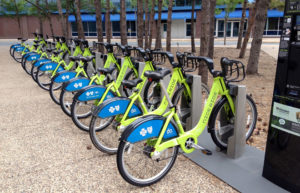
Baltimore’s new bike share system was long awaited. Discussions between the city and various vendors had been ongoing for several years, and recently built downtown cycle tracks indicated political will and ridership momentum for a successful roll out. While ridership had been solid since the system’s start in 2016, cyclists soon began noticing shortages at docking stations even when the app indicated there were bikes available. The truth eventually came out: The system had been victim to massive theft and the system would be shut down for a month for repairs and replacements. While bike share thefts aren’t uncommon, thefts of this magnitude are. Compound this with the public cost of the system, the unpredictability of kiosk bike availability and various shutdowns over the past year, and it’s enough to make any cyclist look for alternatives. What’s the remedy? Perhaps dockless bike share systems.
Over the past 5 years cities have been subsidizing bike share systems across the country. Even with corporate sponsors and non-profit contributions, cities frequent shell out millions of dollars to install systems and keep them running. Proponents call these systems a new form of public transportation which shouldn’t be expected to turn a profit, while critics argue public money shouldn’t be going to “two wheel car rental systems for rich millennials.” A big portion of public funds go towards the docking systems. Bike share systems, up until very recently, have been dock-based. These are the kiosks where you can pick up, return and pay for a bike, and like any other infrastructure they require a lot of money to keep running.
My own experience with bike share systems has been mixed. I’ve used them when I’m out of town on business or vacation in places like San Diego, Miami and DC. The quality of the bikes and location of the kiosks leave a lot to be desired. The biggest inconvenience I’ve found is finding a bike kiosk near both my trip origin and destination. If you’re in a neighborhood with no kiosks, then you’re out of luck and have to make a car or transit trip to the nearest one. And because you can’t stop the clock on your rental without docking at a kiosk, you’re usually renting the bike for more time than you really need when it’s locked up while you’re running errands.
Enter dockless bike share systems. Recently introduced in Seattle and Dallas, these systems are entirely privately funded and free from the confines of kiosks. They can be picked up and returned anywhere, with GPS tracking showing users exactly where bikes are available. A few benefits of these systems I immediately see:
- Pick up and drop off anywhere. For me, this is a big deal. Not having to find the nearest kiosk (which can be several miles apart) and then planning out my bike return route is very convenient. Dockless doesn’t guarantee there will always be a bike near you, but their distribution in many neighborhoods will most likely be better than kiosk systems. And being able to leave the bike anywhere after your trip is done is a big selling point.
- Quick installation, easy expansion. Installation involves placing bikes near existing bike racks and other places where ridership is likely. Expansions don’t have to wait for public funds and kiosk installations. Bike and technology upgrades can happen more quickly without expensive kiosks dictating the timeline of innovation.
- No public costs and management. This means the private sector is entirely responsible for maintenance, support and PR. If a cyclist has a problem with the system, it’s entirely on the bike share operator to resolve the issue if they want to maintain a viable, profitable business.
- Better bikes. Based on my limited bike share use, I’d say dockless bikes are better quality than kiosk based systems. In Dallas, several operators have introduced dockless systems with each fleet being a bit better than the last.
Of course it’s not all flowers and puppies. Dockless systems are still subject to some of the same issues as kiosk based systems like theft and maintenance downtime, but because the system isn’t dependent on expensive kiosks, these issues won’t cripple the system like they have in Baltimore. There’s also the issue of where to place bikes. In Dallas, they often appear in the middle of sidewalks and other odd places. Eventually, public policies may need to be created to make sure they’re not left in places that interfere with pedestrian access or traffic flow. Rebalancing is a less formal process, and guidelines may need to be put in place to make sure bikes are available in a broad cross section of neighborhoods as well. Private systems are also at the mercy of the economy and may lack the permanence of public systems, but with multiple companies stepping into the game, there’s a bit of redundancy if one company goes under.
For now, dockless systems represent a big leap forward for bike access, especially for neighborhoods that wouldn’t have had a kiosk based system for quite some time. Micro-mobility programs fill a needed gap between automobile and pedestrian modes and can help replace a significant number of automobile trips under 3 miles.




